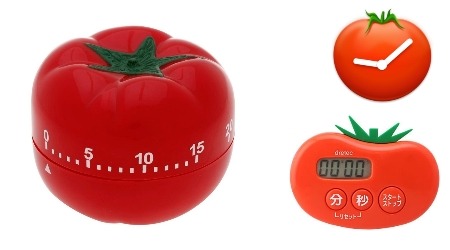

The main shoots and branches grow vigorously and then produce flower clusters at their tips, which stop further stem growth and allow the plant to begin ripening the fruit. Determinateĭeterminate tomatoes have several main stems that produce side shoots freely. Growth habit determines the size of the plant, the pattern of fruit ripening, and the type of plant support and pruning the plant requires.

Tomatoes fall into three categories of growth habit: determinate, indeterminate, or semi-determinate. Local, regional and community food systems.Commercial fishing, crabbing and clamming.Lifehacker the guide to working smarter, faster, and better. "The Pomodoro Technique, or how a tomato made me more productive".
Tomato timer es how to#
Help! : how to be slightly happier, slightly more successful and get a bit more done. The Pomodoro Technique: The Acclaimed Time-Management System That Has Transformed How We Work, p. The Personal MBA: A World-Class Business Education in a Single Volume. ^ "Productivity 101: An Introduction to The Pomodoro Technique".In any case, four check marks indicate a longer break (step 6). Presumably, the piece of paper can be one's task list or similar. WHEN THE POMODORO RINGS, PUT A CHECKMARK ON A PAPER Click the "how" link and see step 4. "The Pomodoro Technique (The Pomodoro)" (PDF). "The Pomodoro Technique: Is It Right For You?".
Tomato timer es software#
The technique has inspired application software for several platforms, with various programs available. Flow and focus become associated with these physical stimuli. The physical act of winding the timer confirms the user's determination to start the task ticking externalises desire to complete the task ringing announces a break. The creator and his proponents encourage a low-tech approach, using a mechanical timer, paper and pencil. As pomodoros are completed, they are recorded, adding to a sense of accomplishment and providing raw data for subsequent self-observation and improvement. In the planning phase, tasks are prioritized by recording them in a "To Do Today" list, enabling users to estimate the effort they will require.

The stages of planning, tracking, recording, processing and visualizing are fundamental to the technique. It’s a good idea to take advantage of the opportunity for overlearning, using the remaining portion of the Pomodoro to review or repeat what you’ve done, make small improvements, and note what you’ve learned until the Pomodoro rings. Specific cases should be handled with common sense: If you finish a task while the Pomodoro is still ticking, the following rule applies: If a Pomodoro begins, it has to ring.


 0 kommentar(er)
0 kommentar(er)
